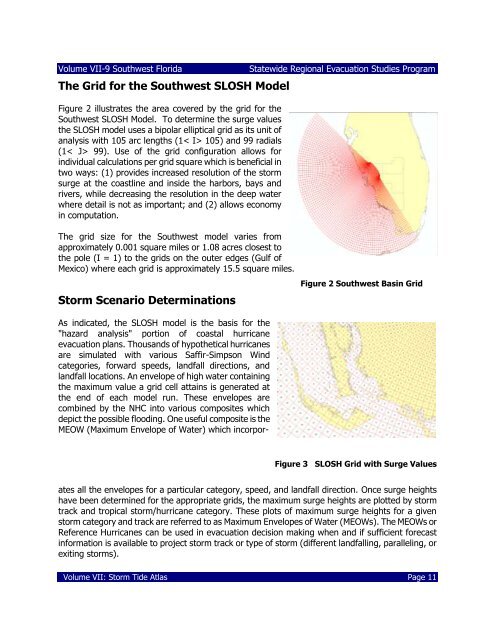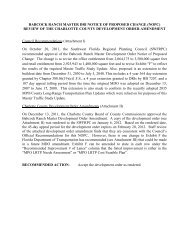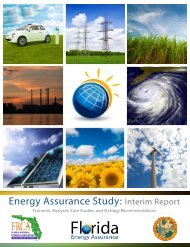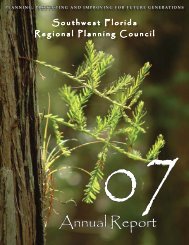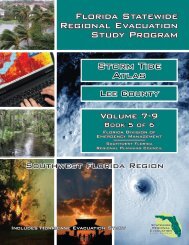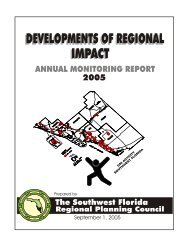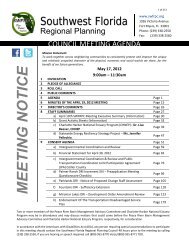Storm Tide Atlas - Southwest Florida Regional Planning Council
Storm Tide Atlas - Southwest Florida Regional Planning Council
Storm Tide Atlas - Southwest Florida Regional Planning Council
You also want an ePaper? Increase the reach of your titles
YUMPU automatically turns print PDFs into web optimized ePapers that Google loves.
Volume VII-9 <strong>Southwest</strong> <strong>Florida</strong><br />
The Grid for the <strong>Southwest</strong> SLOSH Model<br />
Figure 2 illustrates the area covered by the grid for the<br />
<strong>Southwest</strong> SLOSH Model. To determine the surge values<br />
the SLOSH model uses a bipolar elliptical grid as its unit of<br />
analysis with 105 arc lengths (1< I> 105) and 99 radials<br />
(1< J> 99). Use of the grid configuration allows for<br />
individual calculations per grid square which is beneficial in<br />
two ways: (1) provides increased resolution of the storm<br />
surge at the coastline and inside the harbors, bays and<br />
rivers, while decreasing the resolution in the deep water<br />
where detail is not as important; and (2) allows economy<br />
in computation.<br />
Statewide <strong>Regional</strong> Evacuation Studies Program<br />
The grid size for the <strong>Southwest</strong> model varies from<br />
approximately 0.001 square miles or 1.08 acres closest to<br />
the pole (I = 1) to the grids on the outer edges (Gulf of<br />
Mexico) where each grid is approximately 15.5 square miles.<br />
<strong>Storm</strong> Scenario Determinations<br />
Figure 2 <strong>Southwest</strong> Basin Grid<br />
As indicated, the SLOSH model is the basis for the<br />
"hazard analysis" portion of coastal hurricane<br />
evacuation plans. Thousands of hypothetical hurricanes<br />
are simulated with various Saffir-Simpson Wind<br />
categories, forward speeds, landfall directions, and<br />
landfall locations. An envelope of high water containing<br />
the maximum value a grid cell attains is generated at<br />
the end of each model run. These envelopes are<br />
combined by the NHC into various composites which<br />
depict the possible flooding. One useful composite is the<br />
MEOW (Maximum Envelope of Water) which incorpor-<br />
Figure 3 SLOSH Grid with Surge Values<br />
ates all the envelopes for a particular category, speed, and landfall direction. Once surge heights<br />
have been determined for the appropriate grids, the maximum surge heights are plotted by storm<br />
track and tropical storm/hurricane category. These plots of maximum surge heights for a given<br />
storm category and track are referred to as Maximum Envelopes of Water (MEOWs). The MEOWs or<br />
Reference Hurricanes can be used in evacuation decision making when and if sufficient forecast<br />
information is available to project storm track or type of storm (different landfalling, paralleling, or<br />
exiting storms).<br />
Volume VII: <strong>Storm</strong> <strong>Tide</strong> <strong>Atlas</strong> Page 11


